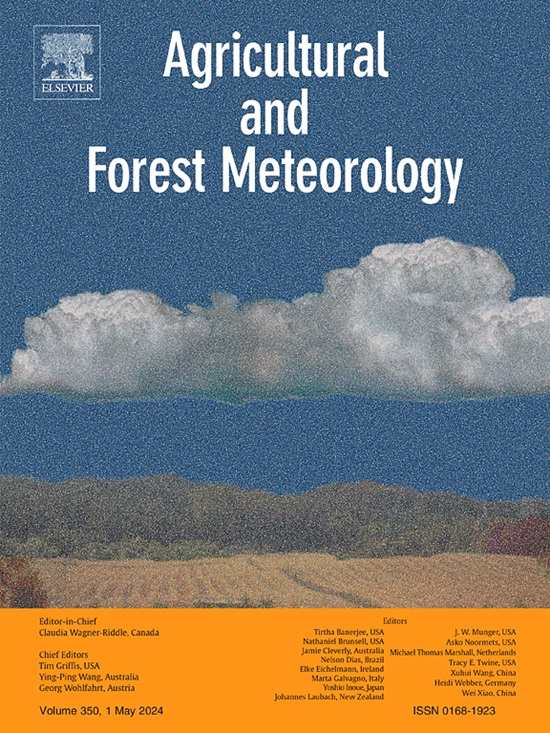秘鲁安第斯山脉中部对流强降雨事件相关的地表能量交换和稳定性条件
IF 5.6
1区 农林科学
Q1 AGRONOMY
引用次数: 0
摘要
本文利用2018年1月至2022年4月的数据和1965年至2018年的气候尺度数据,对位于秘鲁安第斯山脉中部曼塔罗河谷农业区的万卡约地球物理观测站(HYGO)的降水模式、地表能量平衡(SEB)分量和大气垂直梯度(AVG)进行了深入分析。我们的研究结果揭示了不同的日降水和季节性降水模式,峰值出现在下午晚些时候和傍晚早些时候,并且明显的季节变化与干旱和雨季一致。对与对流活动有关的21次强降水事件的分析为天气预报和备灾提供了重要的见解。这些事件是通过现场雨量计、MIRA-35c垂直剖面雷达和GPM-IMERG降雨产品确定的。湍流能量通量:显能量通量(QH)和潜能量通量(QE)采用气动通量梯度法估算,地表热通量采用Foken和Napo格式估算。此外,研究还评价了高级区域预报系统(ARPS)模型在分析这些事件期间湍流能量通量方面的有效性。与整体气动方法的比较表明,ARPS模型在预测QH和QE时分别存在过低估计和过高估计,需要对卫星数据进行集中校准和更新。主要观测结果包括对流降水事件发生前QE和水平动量通量(τ)的显著增加,表明它们是潜在的前兆变量。水汽混合比垂直梯度(WMVG)和理查德森数(RIN)的显著减小,以及水平风梯度(HWVG)的增加,表明地表水汽通量和边界层动力学发生了变化,这对对流降雨的发生至关重要。这一综合分析强调了了解大气动力学对于改进面对气候变率的预测和防备战略的重要性。本文章由计算机程序翻译,如有差异,请以英文原文为准。
Surface energy exchanges and stability conditions associated with convective intense rainfall events on the central Andes of Peru
This study presents an in-depth analysis of precipitation patterns, surface energy balance (SEB) components, and atmospheric vertical gradients (AVG) in the Huancayo Geophysical Observatory (HYGO) situated in an agricultural region inside the Mantaro valley within the central Andes of Peru, utilizing data from January 2018 to April 2022 and climatic-scale data from 1965 to 2018. Our findings reveal distinct daily and seasonal precipitation patterns, with peak occurrences in the late afternoon and early evening hours, and a pronounced seasonal variation aligning with dry and rainy periods. Analysis of 21 intense precipitation events linked to convective activity offers crucial insights for weather forecasting and disaster preparedness. These events were identified using in situ gauge pluviometers, the MIRA-35c vertical profiler radar and GPM-IMERG rainfall products. The turbulent energy fluxes: sensible (Q) and latent (Q) were estimated using the aerodynamic flux-gradient method and the ground heat flux to the surface was estimated with the scheme of Foken and Napo. Moreover, the study evaluates the efficacy of the Advanced Regional Prediction System (ARPS) model in analyzing turbulent energy fluxes during these events. A comparison with the bulk aerodynamic method indicated underestimations and overestimations by the ARPS model in predicting Q and Q, respectively, necessitating focused calibration and updates in satellite-derived data. Key observations include significant increases in Q and horizontal momentum flux () before convective precipitation events, marking them as potential precursor variables. Additionally, notable decreases in water vapor mixing ratio vertical gradient (WMVG) and Richardson number (RIN), along with increases in horizontal wind gradient (HWVG), suggest changes in surface moisture fluxes and boundary layer dynamics, crucial for convective rainfall initiation. This comprehensive analysis underscores the importance of understanding atmospheric dynamics for improved prediction and preparedness strategies in the face of climatic variability.
求助全文
通过发布文献求助,成功后即可免费获取论文全文。
去求助
来源期刊
CiteScore
10.30
自引率
9.70%
发文量
415
审稿时长
69 days
期刊介绍:
Agricultural and Forest Meteorology is an international journal for the publication of original articles and reviews on the inter-relationship between meteorology, agriculture, forestry, and natural ecosystems. Emphasis is on basic and applied scientific research relevant to practical problems in the field of plant and soil sciences, ecology and biogeochemistry as affected by weather as well as climate variability and change. Theoretical models should be tested against experimental data. Articles must appeal to an international audience. Special issues devoted to single topics are also published.
Typical topics include canopy micrometeorology (e.g. canopy radiation transfer, turbulence near the ground, evapotranspiration, energy balance, fluxes of trace gases), micrometeorological instrumentation (e.g., sensors for trace gases, flux measurement instruments, radiation measurement techniques), aerobiology (e.g. the dispersion of pollen, spores, insects and pesticides), biometeorology (e.g. the effect of weather and climate on plant distribution, crop yield, water-use efficiency, and plant phenology), forest-fire/weather interactions, and feedbacks from vegetation to weather and the climate system.

 求助内容:
求助内容: 应助结果提醒方式:
应助结果提醒方式:


